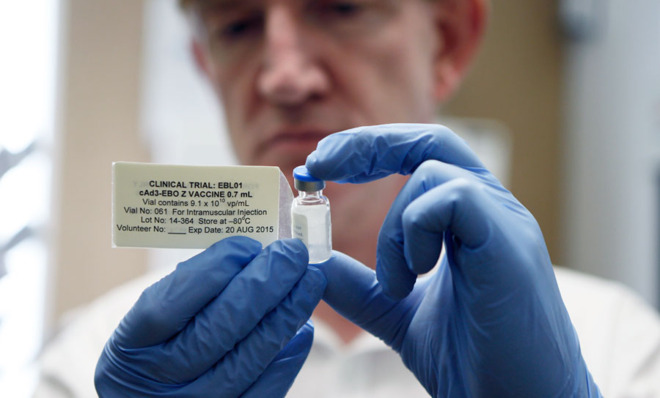We have military research to thank for Ebola vaccines
Shortly after Ebola first broke out in 1976, the Pentagon began looking into countermeasures


Tragically, the Ebola outbreak in West Africa painfully reminds us of the fragile state of health infrastructure in poor countries — as well as of the seemingly limited impact of global health governance.
Though cold comfort, many of the experimental drugs that could help defeat Ebola also remind us of the benefits of military and civilian biodefense R&D.
Biodefense efforts try to limit the damage from biological weapons. The Soviet Union investigated Ebola as a biological weapon during the Cold War, although the Soviets didn't mass produce the virus as a weapon — in contrast to smallpox and other pathogens.
The Week
Escape your echo chamber. Get the facts behind the news, plus analysis from multiple perspectives.

Sign up for The Week's Free Newsletters
From our morning news briefing to a weekly Good News Newsletter, get the best of The Week delivered directly to your inbox.
From our morning news briefing to a weekly Good News Newsletter, get the best of The Week delivered directly to your inbox.
Reportedly, the Japanese cult Aum Shinrikyo also tried to acquire samples of Ebola in 1993 as part of its doomed bioterrorism campaign. Shortly after the first natural cases of Ebola occurred in 1976, the U.S. Army Medical Research Institute for Infectious Diseases — USAMRIID, the military's main biodefense research facility — started to look into countermeasures to this viral hemorrhagic fever.
One important question about biodefense is whether R&D to combat biological warfare and bioterrorism can help to combat naturally occurring outbreaks, as well. It's not uncommon for military technologies to spin off into commercial applications.
Not surprisingly, this "synergy thesis" has its critics. They argue that biodefense distorts public health priorities and may even allow the military to hide an offensive biological weapons program, since some of the knowledge and technology involved is dual use.
It's doubtful that the U.S. military is building biological weapons, given its preference for kinetic warfare. Plus, some investments in biodefense may pay future dividends in the fight against Ebola.
A free daily email with the biggest news stories of the day – and the best features from TheWeek.com
For instance, USAMRIID and the Defense Threat Reduction Agency, along with the Public Health Agency of Canada, supported development of the experimental Ebola drug Zmapp. Granted, Zmapp might not actually work and, even if it does, we just ran out of it for the time being.
But if we were to manufacture this drug in bulk, mass production may involve the Centers for Innovation in Advanced Development and Manufacturing that the U.S. Department of Health and Human Services recently established to help build capacity for biodefense.
Currently, most funding for biodefense comes from civilian sponsors in the United States, not the military. Aside from Zmapp, most of their therapies for other dangerous pathogens — like Marburg virus and Staphylococcal enterotoxin B — get funding from the U.S. National Institutes of Allergy and Infectious Diseases.
Again, Zmapp may fail. Most experimental drugs do. But other medical countermeasures for Ebola relate directly to investments in biodefense, as well. For example, research into one Ebola vaccine began when the U.S. National Institutes of Health asked a Canadian company to reapply technology it had developed for anthrax to also fight Ebola.
Several other potential therapies for Ebola — such as TKM-Ebola and AVI-7537 — also resulted from private collaboration with USAMRIID. So did the GSK/NIAID Ebola vaccine that authorities have just approved for human trials.
Therefore, what little hope there is for vaccines and therapies against naturally occurring Ebola depends in part on research and development for biodefense.
We should welcome these synergies and spinoffs. That being said, new drugs are unlikely to provide quick or easy solutions to the current outbreak.
Instead, the current fight against Ebola now depends on contact tracing, quarantine, and similar public health strategies that date back to the 19th century.
From drones to AKs, high technology to low politics, War is Boring explores how and why we fight above, on, and below an angry world. Sign up for its daily email update here or subscribe to its RSS Feed here.
More from War is Boring...
-
 Political cartoons for December 7
Political cartoons for December 7Cartoons Sunday’s political cartoons include the Trump-tanic, AI Santa, and the search for a moderate Republican
-
 Trump’s poll collapse: can he stop the slide?
Trump’s poll collapse: can he stop the slide?Talking Point President who promised to ease cost-of-living has found that US economic woes can’t be solved ‘via executive fiat’
-
 Sudoku hard: December 7, 2025
Sudoku hard: December 7, 2025The daily hard sudoku puzzle from The Week